Many European immigrants went west to settle in Indiana in the early 19th century. The largest immigrant group to settle in Indiana were Germans, as well as numerous immigrants from Ireland and England. Americans who were primarily ethnically English migrated from the Northern Tier of New York and New England, as well as the mid-Atlantic state of Pennsylvania. The arrival of steamboats on the Ohio River in 1811, and the National Road at Richmond in 1829 greatly facilitated settlement of northern and western Indiana.
Civil War:
During the American Civil War, Indiana became politically influential and played an important role in the affairs of the nation. As the first western state to mobilize for the United States in the war, Indiana had soldiers participating in all of the major engagements.
Indiana remained a largely agricultural state; post-war industries included food processing, such as milling grain, distilling it into alcohol, and meatpacking; building of wagons, buggies, farm machinery, and hardware.
Early 20th Century:
With the onset of the industrial revolution, Indiana industry began to grow at an accelerated rate across the northern part of the state. In the early 20th century, Indiana developed into a strong manufacturing state with ties to the new auto industry. Haynes-Apperson, the nation’s first commercially successful auto company, operated in Kokomo until 1925.

During the 1930s, Indiana, like the rest of the nation, was affected by the Great Depression. The economic downturn had a wide-ranging negative impact on Indiana, such as the decline of urbanization. World War II helped lift the economy in Indiana, as the war required steel, food and other goods that were produced in the state. Roughly 10 percent of Indiana’s population joined the armed forces, while hundreds of industries earned war production contracts and began making war material. Indiana manufactured 4.5 percent of total United States military armaments produced during World War II, ranking eighth among the 48 states.
Modern Era:
With the conclusion of World War II, Indiana rebounded. Industry became the primary employer, a trend that continued into the 1960s. Urbanization during the 1950s and 1960s led to substantial growth in the state’s cities. The auto, steel and pharmaceutical industries topped Indiana’s major businesses.
The 1973 oil crisis created a recession that hurt the automotive industry in Indiana. Companies such as Delco Electronics and Delphi began a long series of downsizing that contributed to high unemployment rates in manufacturing areas. The restructuring and de-industrialization trend continued until the 1980s, when the state economy began to diversify and recover.
Geography:
Located in the Midwestern United States, Indiana is one of eight states that make up the Great Lakes Region. Indiana is bordered on the north by Michigan, on the east by Ohio, and on the west by Illinois. Lake Michigan borders Indiana on the northwest and the Ohio River separates Indiana from Kentucky on the south.
The average altitude of Indiana is about 760 feet above sea level. The highest point in the state is Hoosier Hill in Wayne County at 1,257 feet above sea level.
